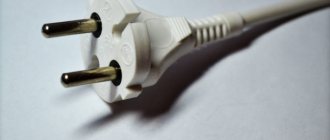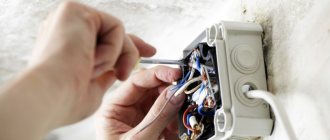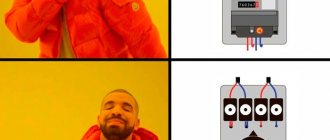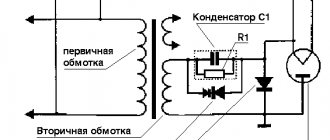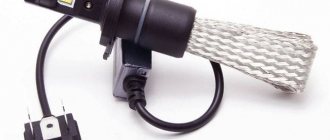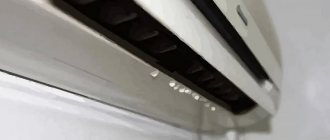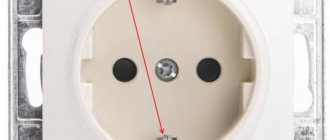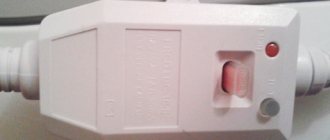What to do if the fork melts and heats up
It is difficult not to notice the melting and heating of the plug; as a rule, during this process the plastic plug slowly heats up, which provokes the formation of a burning smell. The plug darkens in places and acquires a yellowish tint (if it was white). If there are problems with the plug from the device, it is recommended:
- check the degree of load, wire cross-section;
- eliminate possible malfunctions of the plug (deformation of the box is possible due to wear and improper use);
- replace the oxidized wires in the dismountable plug or replace it with a new one.
Load determination using wire cross-section
Often the cause of overheating of sockets or plugs in the apartment is old wiring installed back in Soviet times. In those years there were not so many electrical appliances, and the power was much weaker. Today, residential buildings and old apartments are actually serviced by old, worn-out wiring, which long ago needs to be replaced.
- Option #1. Core diameter. This measurement is carried out by measuring with a caliper. Example:
- aluminum wire, 2.3 mm thick;
- calculation formula: S=0.785 * D², where “S” is the cross-section and “D” is the diameter, respectively, 0.785 is the coefficient figure obtained by dividing “TT” (ground) by the number 4;
- according to calculations, “S” is equal to 4.15 mm (0.785 * 2.3²).
- the resulting number (value) is compared with the given data from the table. (HERE IS A TABLE FROM THE INTERNET, I WILL FIND IT MYSELF)
- Option #2. If the obtained value is not in the table, the calculation is carried out differently. To determine the specific value per 1 mm², it is necessary to find the value for a cross section in the range between 4 and 6 mm: specific current strength - “I”, power - “N” - as the difference between max. and min. values in this interval. The value is divided by the difference in the sections of the interval: “I”=(36-28)/(6-4)=4 A/mm², “N”=(7.9-6.1)/(6-4)=0, 9 W/mm². We multiply these parameters by the difference in cross-section and min. table value of the interval, a number is obtained that is added to the min. the magnitude of the power of the interval (current strength). The required “I” is:
- (4.15-4)*4+28=28.6 A;
- "N"=(4.15-4)*0.9+6.1= 6.24 (W).
The calculated values are compared with those given in the instructions for the devices being switched on. If the required parameters are greater, the wiring cannot cope with the load, which is the cause of the heating.
Trouble-shooting
If the plug is faulty, it must be replaced or repaired (if it is a collapsible type). If the contacts are burnt, clean and insulate. Delay in solving problems can result in a fire.
If the plug from the washing machine melts in the bathroom, what should you do?
Another common problem with heating plugs is that they become heated in the bathroom. As a rule, the fork is heated during intensive operation of the washing machine - when the water is heated by the TEN. It is important to pay attention to a number of reasons:
- Quality socket and plug.
- The socket is moisture protected.
- Oxidation of wires both in the socket and in the plug.
- Washing machine wire cross section.
- Specific load on wiring in the apartment as a whole. In some cases, even old wiring can handle the load. It is just important not to turn on all household appliances in the house at once.
If a simple socket without moisture protection was installed, then over time there is the prospect of oxidation, which leads to heating of the equipment. You should also clean forks or carriers if they are used in the bathroom: dust and dirt are undesirable companions in the operation of the washing machine.
Heating of a plug or socket in an apartment is a common problem that requires an immediate solution. Old wiring and low-quality electrical appliances, as practice shows, are the most common causes of this situation. However, you can deal with this problem yourself, knowing how and why the outlet in the house gets hot.
When you connect the plug to the socket, it heats up: probable causes of the malfunction
There are many devices that are powered by current in the home or office. If in the office there are computer equipment and office equipment, then in the living room there are no less such devices. Often, when you plug in a boiler, refrigerator or washing machine, there is a malfunction in the operation of electrical devices, they begin to heat up, and after a while you can even hear a slight crackling sound, and an unpleasant smell of burnt rubber or plastic is felt in the air. There are several reasons for this malfunction. Depending on what is heating up - the plug or the socket, the method of troubleshooting is determined.
Faulty plug
However, such manifestations are not always characteristic of the device; often the malfunction goes unnoticed, until spontaneous combustion occurs. Therefore, timely detection of plug failure is the key to safety in the home.
You can quickly determine what is faulty – the electrical socket or the plug itself – using a simple experiment:
- Initially turn on the device whose plug heats up in a specific outlet.
- Test the same outlet with other electrical appliances.
- If only one device in the plug heats up, while the others are working properly, then the problem is in the plug. If the plugs connected from the appliances to the socket do not work properly and heat up, the reason is in the wiring of the room or in the socket.
- improper operation of electrical devices;
- contact burnout;
- high load (as a rule, a characteristic feature for carriers and water heaters);
- incorrect cross-section of the wire if we are talking about a DIY extension cord;
- sudden surges in the network that led to a malfunction;
- low-quality device, materials (cheap plugs from China) that were used independently or by the manufacturer.
Socket failure
If the reason for the heating of the appliance plug is a malfunction of the socket, then when the device is plugged into this socket, it will overheat. Fault detection options:
- Visual inspection: external plastic defects, melting, heating - the result of a malfunction.
- Testing an electrical device by plugging it into a given connector. If the plug glows and the plug becomes hot only in this place, the cause of the breakdown is in the socket.
- The load current is higher than the declared capabilities of both equipment and wiring. The result is increased load, overheating.
- Violation of conductor insulation. Failure to comply with the device installation technology is a common and probable cause of overheating.
- Problems with contacts - oxidation or weakening. The solution to the problem is to strip and tighten the contacts, and further isolate them.
- Loose contact systems are also a common cause of malfunctions. Incorrect operation, pulling out plugs of electrical devices with sudden movements from a tight socket entails negative consequences.
Heating due to wiring
- High load on wiring. A common cause is in old panel houses with aluminum wiring.
- Small wire cross-section.
- Incorrect cable routing.
- The service life has expired.
- Improper insertion of copper wiring from old aluminum wiring.
Solving problems with a collapsible fork
A removable fork can usually be repaired. To eliminate the malfunction, initially the wire is disconnected from the device, then the bolts located either in the center or on the sides of the plug are unscrewed
What should you pay attention to initially?
- Bolt fastening. If it is weak, it is worth tightening and fixing the bolt.
- Burnt wires should be cleaned, a small section of insulating material should be cut off, and the insulation should be re-insulated with electrical tape.
- Oxidation of wires and troubleshooting in this case is also done by stripping and insulating, tightening the brands.
Why does the plug in the extension socket get hot?
If the outlet on the extension cord from the store begins to heat up, you should pay attention to the degree of calculated load on the wire. As a rule, the extension cord includes not only devices, but also tees with adapters
In this case, the adapter simply cannot cope with the load.
Video description
Why does the outlet get hot and how to fix it.
Malfunctions in the plug
Models with a cast body cannot be disassembled. If a problem is detected during operation, the sealed structure should not be attempted to be repaired. The wire is carefully cut with a construction knife, the ends of the cable are stripped and fixed to a new plug.
If the model is collapsible, then you can eliminate the faults. If the screw is loose, tighten the part using a screwdriver until it stops. When the insulating material burns, the melted area is cut off, the cable is stripped and fixed on the nut. Oxidation on the contacts is removed with sandpaper.
Collapsible design Source uk-parkovaya.ru
Having determined why the outlet is heating up, it is easy to eliminate the problem yourself. The plug must fit the installed electrical outlet. For technical reasons, the Soviet model should not be connected to a modern design, so it is better to replace the outdated version with a new one.
Wiring irregularities
If the electrical network was installed more than 20 years ago, then the system must be changed. Energy demands have increased significantly. The minimum load in Soviet times barely reached 10 A, so the owners had enough of 2 sockets in each room. Outdated wiring will not withstand the simultaneous inclusion of high-power and medium-sized equipment.
The electrical network in the home is changed when the cable cross-section is small. The wire may be modern copper, but its characteristics are not suitable for the loads. In old houses they used models with a diameter of 1.5 mm. During active use, the network heats up, which causes the machine to turn off.
To keep the sockets from getting hot Source air-ventilation.ru
If you know why the plug in the socket heats up when the washing machine and kettle are running at the same time, then it’s worth replacing the system. When updating the electrical network, they are guided by the actual power. A coefficient for the future reserve is added to the obtained parameters.
Fire
If you don’t figure out why the plug in the socket is heating up, a fire may occur. Failure inside the structure or improper use of an electrical device leads to a fire. Ignition occurs when there is a short circuit in the wiring.
You can extinguish a burning or smoking socket only after turning off the power. Quickly unscrew the plugs or deactivate the machine lever on the electrical panel. To avoid electric shock, do not touch the cable or cord with bare hands. If there is no access to the switch, then use pliers to pull out the problematic element. The tool is only suitable with rubberized handles.
The socket on the wall is on fire Source lider-press.by
It is forbidden to extinguish sockets with water, so the procedure is carried out using powder, carbon dioxide or chemical fire extinguishers. In the absence of special equipment, knock down the flame with a dense natural cloth, which is applied to the flaming element. You can cover the fire with dry sand or earth.
Why does the plug in the socket heat up: wiring faults, elimination of heating
The plug combined with the socket is a quick-release contact connection. In this way, almost any modern equipment can be connected to the network. This method is reliable, simple and convenient if all components of the system are in working order. Otherwise, the plug in the socket gets hot or other problems occur.
Broken wire
A plug or socket will overheat if the wire inside is broken. At the fracture site there is a minimum cross-section of the wire, which is not enough for the current of a given strength to flow. The resistance increases, and as the resistance increases, the electrical wiring heats up. In addition, a broken wire is accompanied by microscopic sparking. The sparks further heat the damaged area.
Why does the wire in electrical appliances and extension cords get hot?
Heating of the wire in electrical appliances is caused by a disproportionate ratio of the cross-section of the wire and the strength of the current that flows through it. If the wire is thin and the appliance is powerful, for example an electric kettle or electric heater, the thin wires will heat up. The same thing happens if a device with a cable of sufficient diameter is connected to an outlet using a household extension cord.
The socket on the washing machine gets hot
If the socket is frequently removed and plugged in, the connectors quickly become damaged.
If the outlet into which the washing machine is connected heats up, this phenomenon may be caused by the following reasons:
- Disproportionate power of the machine connected to the outlet - on the body of the outlet it is indicated what power it is designed for. If the numbers don't match, it will inevitably cause overheating.
- Poor contact between the plug and the socket is observed when connecting a Soviet-style plug to a European socket. The electrodes of the Soviet plug are a millimeter thinner, and therefore the contact density is less.
- The socket itself is faulty. Visually it can be diagnosed by the presence of cracks and melted areas.
- Weak socket contact blades. Due to careless use, the clamps may become loose.
None of these reasons will go away on their own. Measures should be taken to eliminate it.
The water heater plug is getting hot
It is not advisable to use adapters
A water heater is a powerful device. A boiler, for example, has a power of 1.5 to 2.5 kW, and its amperage reaches 12 A. If the plug, socket or cable becomes so hot that it is impossible to touch it, the possible reasons are the following:
- the cable has a cross-section of less than 2.5 mm2;
- there is poor contact of the plug in the socket;
- the water heater is connected via an extension cord;
- A low-quality or old-style socket is installed.
Heating of the boiler plug is acceptable, but the temperature must be within normal limits. A hot, but not scalding body without any traces of melting is not a cause for concern.
Eliminate Heat
Cleaning socket contacts
Repair of electrical appliances begins with turning off the electricity supply in order to completely protect yourself from electric shock: turning off the machine or turning out the plugs. Unscrew the screw in the central part of the socket that secures the plastic cover.
Carry out an external inspection of contacts and wires. If damage is noticed, it is necessary to remove the socket from the seat by loosening the screws that hold it in place.
Then you should cut off the damaged wires, strip them again, place them in the terminal clamps and clamp them carefully.
If traces of melting are visible on the plastic case around the holes for the electrodes, most likely there is poor contact of the electrodes with the contact blades. The problem is solved by pressing the petals with pliers.
If after these manipulations the cause of heating is not eliminated, the plug of the electrical appliance is probably faulty. It is necessary to check the contacts inside it. Moreover, this is only possible if the fork is collapsible.
Upon visual inspection, traces of melting of the wires inside will be noticeable. The repair consists of removing the damaged area and reconnecting the wire to the electrode using a screw. Monolithic forks cannot be disassembled.
When a socket or plug gets hot, make immediate repairs or replace damaged elements
It is important to prevent short circuits and fires, which occur suddenly in such situations
To protect yourself, you must follow the rules for operating electrical appliances, do not exceed the maximum load on the network and refrain from using extension cords and tees.
What can be done?
What can you do yourself, and how to eliminate the cause of overheating? If you see that the contacts at the junction of the wire on the socket or plug mechanism have problems, or carbon deposits have appeared due to sparking, then you should clean the contacts and ends of the cable and securely fix them to each other.
If this does not help, then you will have to replace the outlet. This is especially true for situations where the mechanism itself and contacts are damaged. Overheating of the socket under low load is most often solved by replacing it with a better option. This situation often occurs due to the use of an old outlet that has already exhausted its service life.
Why does the socket melt?
Forum / Electrical / Why does the socket melt?
Ask a question you are interested in on our forum without registration
and you will quickly receive an answer and advice from our specialists and forum visitors! Why are we so sure of this? Because we pay them for it!
Find out details
Treff
Rating: 4
August 19, 2016at 5:56 am
I noticed that the socket into which the boiler was connected had melted a little. This boiler has been powered from this outlet for more than three years and there have been no such problems before. There is a ground connection on the shield. Why is she melting? Should I replace it or may it not be the cause?
Root
Rating: 127
August 19, 2016at 6:51 am
Oxidation of contacts or weakening of the springs pressing the contacts of the socket to the lamellas of the plug. It can be cured, but it is hardly advisable, given the high power of the consumer (boiler). Replace it so that your soul will be at peace. ps Another possible reason is that the clamping of the wires in the terminal connections of the socket has weakened.
Adjacent socket
The adjacent outlet may also become overheated. This occurs in situations where the wires for connecting a series of outlets or two outlets are connected in series, and the connection points themselves are located at the terminals of the outlet mechanism. In this situation, the total load from all connected and active consumers will fall on the contacts of the first and subsequent sockets in the circuit, but especially the first. If the rated value is exceeded, the adjacent outlet itself will begin to heat up.
Here it is important to ensure that when switching a series of sockets in this way, the threshold load values are not violated.
The water heater plug is getting hot
Tighten it, and if the heating goes away, you don’t have to change the socket.
Anatoly Shabalin
Rating: 34
August 19, 2016at 7:58 am
I agree with what Root said. But it is also important what kind of outlet it is. More precisely, what load is it designed for?
And the body material. Look for one with a ceramic body. They are usually more powerful. And of course not Chinese.
vitas64
Rating: 85
August 19, 2016at 8:37 am
The socket melts because too much load is passing through it. Over time, the contact plates or springs weaken and carbon deposits form on them. The socket needs to be replaced or the contacts bent and cleaned, but I would install a two-way breaker instead of the socket.
VLAD
Rating: 67
19 August 2016at 21:15
The problem most likely was in the contact plates or springs; they weakened over time and the contact began to deteriorate. Therefore, the socket began to melt. It would be better to replace it with a new one for reliability.
Load determination using wire cross-section
To check the wiring capabilities and determine the maximum load for a specific electrical network, you need to find out the cross-sectional area of the wire and perform calculations:
- First, you should determine the diameter of the core using a caliper. The actual cross-sectional area is found using the formula: Sф.=0.785*D2. Instead of “D”, substitute the measurement result.
- To calculate the specific current and power, you must find the difference between the maximum and minimum values in the interval in which the calculated cross-sectional area falls. The difference in specific current strength is divided by the difference in cross sections in the same interval, where the smaller value is index 1, and the larger value is index 2, namely Isp. = (I2-I1)/(S2/S1). The value is obtained in A/mm2. Specific power is found in a similar way: Nsp.=(N2-N1)/(S2/S1). The required current and power values are calculated using the formulas: Isq.=(Sph.-S1)*Isp.+I1 and Nsq.=(Sph.-S1)*Nsp.+N1.
If the values obtained in the calculations are less than those indicated in the instructions for electrical appliances, the cause of heating is weak electrical wiring.
Heating due to wiring
The electrical network is able to cope normally with certain loads. For this purpose, special calculations are carried out. The cross-section of the wire is decisive.
This may not be taken into account in the following cases:
- Many houses were built in Soviet times, when electricity consumption, installed appliances and their number were different.
- Sometimes in new buildings, unscrupulous developers make such calculations incorrectly.
- In houses, people do the wiring themselves, not knowing all the rules or neglecting them, or they entrust the work to the wrong specialists.
Most buildings now use aluminum cable with a diameter of 2.5 mm or less. Such wiring can withstand a current of about 20 A, a power of approximately 4.4 W. If you simultaneously connect several powerful devices such as a washing machine to a contact pair, the normal load may be exceeded. The consequences will not be long in coming.
If the outlet gets hot and other symptoms are noticeable:
- It is advisable to find out the required parameters and replace the wiring. Copper is better.
- It is necessary to monitor the load level on the contact pair (plug, socket).
In the latter case, you need to keep in mind that the load is summed up:
- if there are many branches, but the feeding nest is the only one;
- if there are several contact pairs, but they are connected in series.
Symptoms of the problem
Under normal conditions, network devices should not become hot. If you touch the plastic while electrical appliances are running, the plug, cable or socket will always remain cold. Even a slight increase in temperature warns of problems in functioning.
At the first stages, the processes inside the devices go unnoticed by the user. A person pays attention already when an unpleasant smell of burning or sparks appears. Upon contact, the element produces an electric shock. If the outlet gets hot, there is a problem with the design.
Symptoms of device malfunction Source zen.yandex.ru
If changes are ignored, the device damages the fuses of switched on electrical devices, which leads to the combustion of electronic chips. Automatic protection in the shield is supposed to protect the equipment from troubles, but it wears out over time. If neglected, the problem will cause a fire.
How to fix the network connection point
Heating of the device, a burning smell, and the appearance of sparks even under normal load indicate that the device should be disassembled to determine the cause of the malfunction. And then the cause must be eliminated.
Turn off the electricity supplied to the suspicious connection point. This can be done by turning the handle of an old bag, unscrewing the plugs, or using automatic fuses. Check the presence of voltage in the network after disconnection. Use an indicator screwdriver or a work desk lamp. After making sure that the light does not come on, proceed to disassembly. Remove the cover from the device. Loosen the screws of the tabs that secure the operating mechanism in the socket
Carefully remove the interior and wires for further analysis.
When inspecting the device, the following faults are most often found:
- The clamping of the power supply cores that connect the distribution mechanism to the wiring in the room has become loose. This damage is more common with soft aluminum conductors. Their ends should be inspected and crumbled parts should be removed. Remove insulation from about 9 mm of the entire wire. Secure them with clamps and assemble the socket. If the wires are copper, you need to tighten the clamp screws using a screwdriver.
- Deformation of the contact plates located in the device sockets. It is a consequence of plastic melting when the load is exceeded. A socket with such a breakdown must be replaced.
- If the device is a pass-through device (that is, the next one comes from it), then even without the plug on it can heat up. The product should be disassembled and the clamps and plates checked. After correction, assemble and check the quality of work.
Dangerous cable: why electrical wires get hot
Heating of electrical wires is a dangerous phenomenon, which can cause the protective insulation to melt and cause the electrical wiring to ignite.
Main reasons for heating:
- The wiring is not installed correctly;
- Poor twisting of wires;
- Poor cable quality;
- Inability of the cable to withstand the load.
In most cases, wires heat up if the cross-section is incorrectly selected. They cannot withstand the modern load of household appliances. It is necessary to limit the number of simultaneous connections of several devices or completely replace the wiring with modern materials.
The cable in the apartment must have a cross-section of at least 2.5 square meters. mm for connecting to sockets, and 1.5 sq. mm for lighting.
If the old wiring was equipped with a copper cable, then the aluminum wire must be connected through special terminal blocks. Aluminum and copper have different electrical conductivities and should not come into contact, otherwise heating of the cable cannot be avoided.
If the wiring in the house heats up, melts and flares up, you must urgently take the following steps:
- Disconnect the apartment;
- Cut the wire with a tool with wooden handles;
- Cover the flame with a rag.
If you are unable to extinguish the flame yourself, immediately call the fire department.
Arrangement of plugs and sockets
The power plug for an electrical appliance is an insulating plastic casing, from which two metal pins protrude, and on the opposite side or side there is a wire cord. The plug body contains wires that are tightly fastened with screw connections to the bases of the pins. Such forks are collapsible and can be repaired or replaced. In the same way, using a screw connection, the wires of the apartment's electrical network are attached to the sockets of the socket. To ensure tight contact in the plug connection with the socket, both must be of the same type. It is unacceptable to insert a traditional Russian plug into a Euro socket.
Why does the plug from the extension cord in the socket heat up when the water heater is turned on?
Features of a household network. Let's learn electrical installation... Everything a self-taught electrician needs to know. Self-instruction manual. Features of household lighting…
We make safe wiring. How does a differential device work... How to ensure the safety of electrical wiring? Automation. Electric automatic,…
Laying the electrical wire. How to select and lay wiring with... How to choose an electrical wire? Its choice, types, types, classification. Gasket…
Why does it generate electricity from water pipes, taps, faucets?... Why can it generate electricity from water pipes, taps? Causes of electric...
Why does a wooden floor squeak... My practical experience in dealing with floor squeaks. And also advice from old people. How do I get off...
The heating stove is an original stove design…. An interesting design of a heating stove with adjustable room heating...
Eliminate Heat
Before you begin to troubleshoot any problems associated with electrical appliances, you must first stop the current supply to them. To achieve this, you need to turn off the machine, or unscrew the plugs on the electrical panel, after which the cover is removed from the socket, which is secured with a screw in the central part of its body.
If it is noticeable that the contact wires have been exposed to high temperatures, then this is the reason for the heating of the socket. To bring them back to normal, you need to completely remove the socket from its socket, after loosening the screws that secured it. After this, clean the contacts and place them back into the contact clamps, properly tightening the mounting screws. Then the socket is assembled and installed in its place.
If the reason is not in the contacts, but in loose connectors into which the plug electrodes fit, then they are simply tightened with pliers and the repair can be considered complete.
When cracks or even traces of exposure to high temperatures are found on the socket body, the socket cannot be used. It must be replaced. The socket is also replaced if there are no springs in it.
The next step is to check the plug. Forks are available in two types: collapsible and monolithic. Inspection is possible only with a collapsible fork. To do this, you need to disassemble it by unscrewing the screw fastening in the center of the case and inspect the wires inside, which pass inside. Melted insulation indicates that the contact in this place is weakened.
This section of the wire is removed, after which the insulation is removed from the undamaged section of the wire, and it is connected to the electrode using a screw.
In order to notice in time when it is necessary to repair a socket or plug, you need to pay attention to their temperature; it is best to do this every time the plug is removed from the socket. Related materials:
Related materials:
Contrary to the widespread installation of gas equipment, which took place during Soviet times, today electric...
One of the most important components of the electrical network is the plug socket. Its main function is to connect household and other appliances to electricity. ...
When planning the location of cabinet furniture in the kitchen, a reasonable solution would be to plan the location of sockets. The modern electrical goods market offers customers a rich…
Almost all electrical appliances are connected to the network using a plug that is inserted into a wall outlet. This connection is called a plug connection. The plug is usually connected to the appliance by an electrical cord. However, there are many household electrical appliances that are attached directly to the plug. These are, for example, chargers for iPods, AA batteries, electric fumigators, and insect repellents.
Why does the socket on the washing machine get hot?
» Sockets » Why does the socket on the washing machine get hot 08/31.
2015
- 1 What is the reason
- 2 The plug must be compatible
- 3 Eliminate heat
In order to prevent short circuits, burnt wires and thereby prevent damage to household electrical appliances, it is necessary to regularly check the condition of the sockets. After all, it is always easier and cheaper to prevent a minor breakdown than to later pay for your sluggishness not only with money, but possibly with your health.
If the outlet is heating up, then you should not hope that the reason for this will simply disappear, without outside intervention.
Heating of the outlet can be caused by various reasons, including:
- Excessive power of electrical appliances connected to the outlet.
- Unstable contact of the plug inside the socket.
- Malfunction of the connectors inside the socket.
- The contact of the socket clamp is not tight enough.
What is the reason
In most cases, sockets burn out due to multiple excess power of various electrical appliances that are connected to it.
You should know that on the body of any outlet there is relevant information in numbers that helps solve the problem before it occurs.
You just need to know the power of electrical appliances connected to the network and compare these numbers with those indicated on the outlet.
If several devices are simultaneously connected to one outlet, this will certainly cause an overload, the resistance will rise and the outlet will begin to heat up quickly
To prevent heating of both the plug and the outlet itself, it is important to control the extent to which power sources are loaded
Often, the reason for an insecure connection between the socket and the plug is the unsatisfactory fixation of the plug with the connectors inside the socket. Old-style plugs from the times of the USSR are still very common, but their electrodes are almost a millimeter thinner than the electrodes of modern sockets, and the electrodes themselves are located at the same distance on both types of sockets.
The plug must be compatible
You need to be careful and not try to connect a Soviet plug into a modern socket: this will certainly cause it to heat up, due to the guaranteed weak contact with the connectors inside the socket.
If the socket is subjected to frequent mechanical stress, that is, the plug is often removed and inserted, then the socket connectors quickly fail and cannot sufficiently fix the electrodes. This also causes the outlet to heat up.
Probably the best wire material to use for wiring is copper rather than aluminum. And the point here is not electrical conductivity or resistance difference. The fact is that aluminum has one drawback: it is very plastic and, over time, tends to leak out from under the contact clamps. This weakens the screw clamp and inevitably causes the socket to heat up.
Problems in contact connectors: why the plug melts in the socket
In some cases, the plug may not only heat up, but even melt. If the reason is not in the plug, it is necessary to diagnose the socket.
The main reasons for heating and melting of the fork:
- The power of the device is higher than the declared norm;
- The socket is out of order: the clamps are loose;
- Plug and socket do not comply with standards.
First you need to compare the technical characteristics of the outlet and the load of the device on it. The manufacturer puts information on acceptable standards on its product. If you turn on a device with a higher power, the socket begins to heat up, operating in an increased mode. Accordingly, the plug inserted into the contacts of the device also heats up.
To fix the problem, you need to turn off the power to the apartment and disassemble the connector.
The reasons for heating and melting may be the following:
- The contact spring has weakened or broken;
- The contacts of the plate have come off;
- The ends of the wire are burnt or flattened;
- Internal elements melted;
- The socket body was charred and crumbled.
Loose clamps must be tightened with a screwdriver. Remove the aluminum wires from the contacts, inspect for integrity, remove the insulation and re-fasten the screws into the clamp. Bend the contact plates and replace if necessary.
Why does the outlet get hot?
Secrets of handling equipment
Heating of the plug of a household electrical appliance or socket is evidence of serious problems, which must be eliminated as soon as possible.
Overloaded socket
When you discover that an electrical outlet or plug in a household appliance has begun to heat up, the first thing to do is compare the load on the outlet and its technical characteristics.
You won’t have to look for them for long; on each socket the manufacturer provides information about the maximum permissible voltage and current values.
The inscription “6A 220V” will indicate that the power of the electrical device plugged into the outlet should not exceed 1.3 kW (6A x 220V).
If a heater with a power of one and a half kilowatts is plugged into such an outlet, then it is not surprising that the outlet will heat up, since it will work beyond its capabilities.
A socket rated “10A 220V” is designed for continuous operation with a consumer power of no more than 2.2 kV (10A x 220V), and the maximum power of a device that can be powered without consequences from a socket marked “16A 220V” is 3.5 kW ( 16A x 220V).
There are two ways out of this situation: either use/install an outlet with a higher rating, or monitor the total power of the devices included in it.
Plug fault
If the outlet rating allows the use of an electrical appliance of a certain power, but the plug in the outlet still gets hot, plug the device into a different outlet. Reheating the fork will unmistakably indicate that the problem lies in the fork itself.
Troubleshooting methods depend on the plug form factor. For a collapsible plug, check that the wires are securely attached to the contacts and, if necessary, tighten the fastening screws.
If the ends of the wires are oxidized or burnt, cut the end of the connecting cable, remove the insulation from the ends of the conductors and re-install the contact groups.
Rarely, but still there are plugs of the “Soviet” type, the thickness of the contact pins of which is much less than that of modern plugs. This type of plug does not fit tightly into the socket, so the best way out of this situation is to replace it with a new, modern model.
Socket problems
If the outlet gets hot no matter what device is plugged into it, that is the cause of the malfunction.
Before starting work, be sure to turn off the power to the apartment!
Unscrew the screw and remove the cover from the socket. To diagnose the socket, loosen the bolts of the fastening tabs (if the socket is built-in) or unscrew the fastening screws (if the socket is surface-mounted). Slightly bend the wire, move the socket away from the wall and begin inspection.
First of all, check the fastening of the wires supplying power to the outlet. If the wiring is made of wire with copper cores, tighten the clamp bolts with a screwdriver.
If the socket is powered by aluminum wires, remove their ends from the contact clamps and carefully examine them. Bite off the burnt, crumbled and melted ends of the wires, remove the insulation from them, insert them into the clamps and tighten the fastening screws thoroughly.
After a month or two, be sure to return to this outlet and tighten the clamp screws. Due to the softness of aluminum, the ends of the wires fixed with clamps can change their shape (as electricians say, “aluminum flows”), as a result, the contact in the socket will inevitably weaken.
Check the contact plates and contact springs. If necessary, bend them or replace them with new ones.
Pay close attention to the parts of the socket body: if they are cracked, charred or melted, the socket must be replaced with a new one. What should you do if the outlet heats up and nothing is plugged into it? Yes, this happens too
And only if another outlet is powered from it
What should you do if the outlet heats up and nothing is plugged into it? Yes, this happens too. And only if another outlet is powered from it.
If the technical condition of the pass-through socket is poor, it will heat up. It is for this reason that each outlet must be connected with a separate conductor to the distribution box.
Check the condition of the heated feed-through socket, tighten the contacts, eliminate defects, or even better, replace it with a new one.
Source
Causes of sparks in an outlet
A blown electrical outlet may cause a fire or seriously damage the plug.
The purpose of the plug socket is to connect the plug with the electrical network. During normal operation, current flows through the contacts with minimal heat generation. In some cases, when inserting a plug into a socket, a breakdown occurs. The higher the power of the device being turned on, the more intense the sparking and crackling. The temperature of the electric arc is very high, and a characteristic smell of molten plastic appears.
Sockets crack for several reasons:
- Exceeding the power for which the electrical installation product is designed.
- Long service life and natural wear of connectors.
- Loosening of contact clamps.
- The plug connection parts are manufactured to different standards.
- The product supplied was of low quality and had a short service life.
If the socket shorts out when you turn on electrical appliances, you should temporarily use another power point. There are several factors leading to failure.
Overload
Rated current on the socket body
Electrical installation structures are designed for a certain rated current. The parameter is indicated by the manufacturer on the panel. Before the advent of powerful household appliances, it was sufficient to install a product with a current of 6-10 A, now the figure is 16 A. For three-phase networks, the parameter is at least 32 A. Exceeding the rated current leads to heating of metal parts. High power of equipment increases the load on electrical wiring. For safety reasons, it is made of cable with copper conductors.
The formula P=IxU will help you calculate the permissible power, where P is power, I is current, U is voltage. For example: P=10×220=2200 (W). A socket with a rated current of 10 A can withstand connecting devices with a total power of up to 2.2 kW.
Worn connectors
The result of a worn socket connector
The contact terminals bear a high load. They are designed for a specific resource. After several years of use, if you frequently insert and pull out the plug, the contact plates will loosen. They do not fit tightly around the pins. Intermittent contact causes crackling noises and sparks. The socket begins to warm up and hiss when the metal is covered with a layer of oxide. The process arises from moisture. The springing properties of oxidized metal are reduced. To extend the life of the device, it is worth turning off the devices with a special button, and not by pulling out the plug.
Loosening screw terminals
Socket contact screw terminals
If you hear a cracking sound in the outlet, the cause may be loose screw connections. The situation arises due to heating and deformation of the metal. The process occurs in all electrical installation products, so experts recommend carrying out preventive tightening of contacts once every 2 years. Aluminum wires are checked more often
When pulling, it is important not to pinch the core, otherwise it will become deformed. One of the mistakes that unskilled installers make is using a long screw.
The fastener rests against the wall and does not allow the contact to be properly tightened.
During installation, it is advisable to wrap the wire in a loop around the screw. This method significantly increases the contact area. Modern devices are manufactured using screwless technology. Their installation is simplified and preventive maintenance is not required.
Mismatch of selected plug parts
a) Soviet standard fork, b) Shucko fork
Plugs and sockets are manufactured to standard sizes. In Russia, two designs are used:
- The European Type C or Europlug is a plug with two parallel round pins. The distance between them is 19 mm, diameter 4 mm.
- Type F or Schuco - plug with protective contact, grounding. It is widely used in Europe, popular in Russia and the CIS countries. The plug pins have a diameter of 4.8 mm.
Also, due to poor contact with plug C, the socket intended for type F plugs sparks. The connection is acceptable for low-power devices, but overheating occurs with high power consumption.
Poor device quality
Inexpensive electrical installation products quickly become unusable. They use thin plates, unreliable fastening, and the contacts are loosely tightened. Chinese products have low cost due to low quality. It does not correspond to the declared power and quickly becomes loose during operation. Due to the high load, the sockets hiss and fail after a maximum of 2 years.
a) Original Legrand socket, b) Counterfeit
High-quality products in the budget segment - products from Vico and Makel. European brands Legrand and ABB have inexpensive series.
Plug compatibility
When turning on various equipment, you need to remember that the plug must match the outlet. Under no circumstances should you put a Soviet plug into a Euro socket. Because heating will occur due to weak contacts inside the socket.
Frequent use of the socket also leads to the fact that the connectors cannot securely fix the electrodes.
Carrying nuances
An extension cord is also one of the devices whose cord heats up when connecting various types of equipment. It is not recommended to use extension cords because today the market is overflowing with low-quality products from China. Fires often occur due to the use of cheap fakes. There have been cases in which the extension cord simply melted when the washing machine was turned on. Therefore, take your choice of extension cord seriously to avoid any trouble.
A quality carrier can also get hot if it's on a reel. This happens because the wound wire heats up faster due to the appearance of inductance. To prevent this from happening when connecting powerful equipment, the coil is unwound.
It is better to use copper wire for wiring. Since aluminum is a plastic material and will slip out of the clamps over time. And poor contact, as always, leads to heating. If your washing machine is broken, then the best solution is to call a washing machine repairman to your home.
Problems with spinning clothes
In this short article we will tell you about the main reasons for the lack of spin in a washing machine, as well as methods for eliminating this problem.
The washing machine does not spin the drum
If the drum in your washing machine suddenly stops, do not panic. Not in all cases this indicates a breakdown in the equipment. Perhaps the reason was the usual overload of the machine. But there are still more serious reasons. Until they are clarified, it is not recommended to use the machine.
Replacing bearings and oil seals of a washing machine
How to change bearings and seal in a washing machine? Some tips from our workshop.
What to do if your washing machine is leaking?
What to do if your washing machine is leaking? How serious is this problem and how can it be fixed?
How to determine why the washing machine does not turn on?
How to determine why the washing machine does not turn on? The range of reasons that can lead to a malfunction of a washing machine is quite wide. However, by consistently performing a series of simple diagnostic steps, it is quite possible to identify the cause of the malfunction.
Why doesn't the washing machine drain water?
Some reasons why your washing machine won't drain and how to fix them.
What can be concluded? How to protect wiring and apartment from fire?
- The boiler should be installed by an experienced specialist.
Do not trust your neighbor “Vasya” at home or the “Specialists from the advertisements”. Only an experienced technician knows all the nuances and pitfalls of correctly installing a boiler. Contact service centers.
Do not turn on powerful household appliances at the same time.
Do not load the apartment's wiring to the maximum.
The boiler must have a personal, separate, high-quality outlet.
All contacts on the connections must be securely fastened.
Remember, the work of drowning people is the work of the drowning people themselves! Having problems? Urgently call specialists and get rid of them!
This is interesting: Connecting a current transformer to a Mercury 230 meter - this is important to know
Main reasons
There may be several reasons why the outlet gets hot; the most typical situations can be defined as follows:
- the fork gets hot;
- The socket gets hot;
- problems with contacts in the socket mechanism, poor contact;
- the reason is in the wiring;
- unacceptable current and power values.
These points should be discussed in more detail. However, before this, it is worth mentioning that sockets and plugs should not get hot. A slight heating under load is allowed, but it should be insignificant. If you notice heating without load, when the plug is not in the socket, then the cause should be identified and eliminated as soon as possible.
Outlet fault
The socket, as the cause of heating of the contact pair, may, after opening, reveal the following shortcomings:
- The contact spring is loose, broken or missing.
- The brass contact plates have become bent and loosened.
- The ends of the supply wire are loose in the terminal contact.
- The end of the wire is burnt out or flattened, resulting in loss of contact.
- The internal elements of the device melted, as a result the distance between the brass contact plates increased.
- The plastic or carbolite of the body is charred.
To troubleshoot problems, take the following measures:
- A faulty spring must be replaced or preloaded using a spacer.
- Brass plates can be bent and compressed to reduce the intermediate section.
- All bolted connections must be tightened until they stop.
- If the supply wire is defective, you should bite off the end with pliers, strip off 6–8 mm of insulation and redo the contact.
- In case of melting or charring, as well as cracking of the housing elements, the socket must be replaced.
Faulty plug
There is no point in delaying repairs - the socket may spark and an unpleasant burning smell will appear. In addition to equipment failure, it is simply dangerous, for example due to the risk of fire or electric shock. It is necessary to limit the use of sockets and plugs, or better yet, stop.
If smoke or other serious signs appear, turn off the electricity. Usually the switch is located in the meter on the distribution panel. You need to hire a specialist or fix it yourself. Work is carried out after a power outage.
There may be several reasons for heating. First of all, you need to check the plug. It is inserted into a working socket. The load is given: the device turns on. You need to wait 5 - 15 minutes and assess the condition. If the plug gets hot, that means it's the problem. If not, you need to look further for the reason.
If the plug breaks, you can replace it or try to repair it.
Socket failure
If the check shows that the plug is working, you need to make sure that the socket is working properly. A device with a known working plug is inserted into the outlet. After turning on, you need to wait 5 - 15 minutes.
The results may be like this:
- The plug, socket, or both elements heat up. The reason is the socket.
- None of the contact surfaces got hot. A mistake was made, you need to repeat the check from the very beginning: from examining the fork.
The socket may have unsuitable characteristics. If a boiler is connected, the device must be able to withstand at least 16 A. If the socket lights up or there are other signs of overheating, it is likely that the cause is low readings. The socket was working at its maximum capacity.
Malfunctions and their elimination
If the socket is faulty, it can be replaced, disassembled and repaired.
- The terminal does not clamp the wire well enough. The bolt should be tightened until it stops.
- The spring does not function well: it is damaged, holds weakly or is missing. You need to tighten it/install a new one.
- The brass plates are deformed and do not provide a tight connection. You can bend it and put it in the correct position.
- The tip of the wire is damaged and the insulation has melted. A new contact is made: the damaged area is cut off, the insulation is removed by about 7 mm, and reinserted into the terminal.
- Sometimes the socket melts. In this case, the body and internal elements made of plastic (carbolite) are damaged. Brass plates can change position and lose contact. The socket is replaced with a new one.
The first warning signs are that the plug heats up when in contact with the socket
The number of electrically powered equipment is increasing every year. At the same time, the risk of spontaneous combustion increases if the socket or wiring is installed incorrectly. Heating of the socket when an electrical appliance is turned on is the first signal of a malfunction.
The quick-release contact device - a plug - is simple and reliable. However, in some situations, malfunctions occur that can have negative consequences for the home. More often, the owner of the premises has to find out the reason why the plug of the device begins to heat up in the socket. Here you cannot delay in diagnosing and solving the problem.
Fifth reason. Rarely, but it happens.
I once had a case:
The client's circuit breaker was knocked out. But at the same time, not a single device was connected to any outlet.
After a long “dance with a tambourine”, I saw that one of the sockets had obvious signs of burning. And only when I removed the socket did the machine stop knocking out.
And the reason turned out to be this: there was such strong carbon deposits around the contacts of the socket (the carbon deposits in the photo below are indicated in yellow) that the surface became conductive. Apparently carbon was released from the plastic.
I measured the resistance between the contacts... It turned out to be only 10 Ohms!!! When this socket was connected to the network, a clearly visible spark jumped across the soot... In short, the soot became a jumper.
So, if the body of your outlet begins to burn, change it without hesitation and quickly!
Video version of this article:
Useful video
Modern technology is found at work, in public places, and at home. However, no matter what new devices and their modifications manufacturers produce, the devices work in the old proven combination: plug (plug) and socket.
The quick release contact device is simple and reliable, but malfunctions sometimes occur. Most often you have to find out the reason why the plug in the socket gets hot.
If the problem is not in the plug, then it is possible
The outlet is overloaded.
Let's look at what's plugged into the outlet.
A common situation is when, due to a lack of sockets, tees or extension cords are inserted into it to connect something else needed. But the possibilities of the outlet are not limitless! On each socket the manufacturer indicates its rating, for example: “10A 220V”. This means that this device is designed for continuous operation at a current not exceeding 10 amperes and a voltage of 220 volts.
To find out how much power can be obtained from this device without DESTROYING it, we multiply 10A with 220V, we get 2200 watts or 2.2 kilowatts. Now let’s count how many of us are connected at the same time? Every modern electrical appliance has its power marked on it, which gives us the opportunity to determine whether our socket will withstand this device! If the power of all the switched on devices exceeds the capacity of the outlet, is it surprising that it heats up?
What is the way out of this situation? Additional sockets on the wall will not appear on their own, and if they do, it will not be soon! All you have to do is make sure that the devices connected to this outlet are not turned on at the same time! For example: while turning on a modern powerful kettle, we turn off the two-kilowatt heater; in two minutes of operation of the kettle, the kitchen will not cool down without the heater working!
Now let's look at the options when the outlet heats up and sparks from any load.
Here you can’t do without disassembling the outlet itself. First of all, WE TURN OFF the ELECTRICITY supplied to our outlet, and if you are not sure that you have turned off what you need, we completely cut off the power to the apartment!
Look in your electrical panel to see what you can do to turn it off, the options may be different: before your meter, and sometimes after it, there may be a bag - a black, can-like thing with a handle that can be rotated clockwise DO NOT TOUCH - DANGEROUS! (many cases when they died of “old age” when trying to switch off with serious consequences); modern white flat machines or old, Soviet-era black flat machines; push-button automatic fuses, screwed into special sockets along a thread, or even ancient white ceramic fuses, popularly called plugs. If the electrical panel is located on the staircase, you must make sure that these devices belong specifically to your apartment, and not to the neighboring one! If you couldn’t figure out how to turn off the voltage supplied to your apartment, abandon your idea of doing the repairs yourself and call an electrician! So: we turned off everything that was possible, unscrewed it, now we check the presence of voltage in the apartment.
We take a table lamp or a vacuum cleaner and check all the sockets. If it is dark or quiet, we proceed to disassemble the socket. In principle, there are special devices for such purposes, for example: an indicator screwdriver, which is sold in any tool store. However, the article can be read by a person very far from electricity and, for him, the presence of such a voltage indicator in the house is equivalent to the presence of a wrench in a handbag! Although it wouldn’t hurt to have such a device at home, we still live among “electricity!” Remove the cover from the socket, loosen the screws of the tabs that hold the socket in the socket if it is built into the wall, and carefully remove the inner part with the wires for inspection.
Briefly about electrical safety
If, when operating electrical appliances, the socket sparks when the plug is inserted or it heats up, you must do the following:
- disconnect consumers from the problematic outlet and protect it from use;
- if smoke appears from the contact device, it is necessary to turn off the corresponding bag on the distribution panel;
- exclude the inclusion of an electrical appliance whose plug heats up;
- limit the load on the outlet into which the device with the heating plug was plugged in;
- seek professional advice and diagnostics if your own skills and experience do not allow you to solve the problem.
